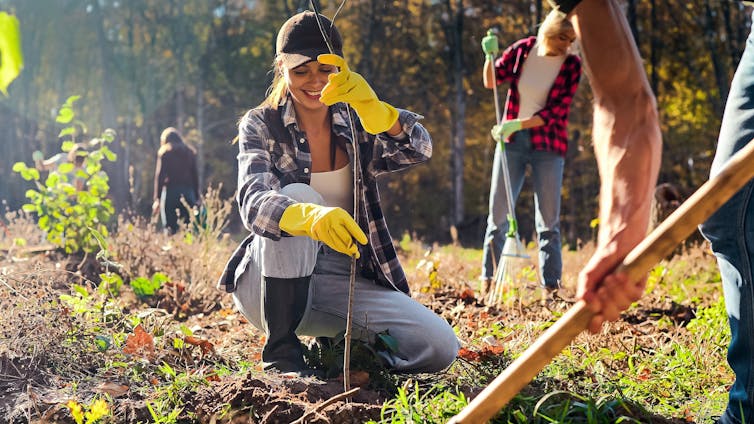Source: The Conversation – UK – By Bella Zanin, Knowledge Exchange Associate, Centre for Climate Change and Social Transformations, University of Bath
How often do you chat about climate change? When the weather’s been “a bit crazy”? Maybe with an estranged uncle over Christmas dinner? Recent polling reveals that over half of British adults rarely or never share their opinions about our warming planet.
Why does this matter? Because talking about climate change is one of the most important things we can do to tackle it. Conversations shape social norms, and social norms shape behaviour.
To be clear: it’s not about convincing your friends, family, neighbours or colleagues to care about climate change. Chances are they already do. It’s about letting them know you care too – that it’s normal to care, and typical to take action.
Talking about climate change is how we break the taboo, build a sense of unity, inspire hope and kickstart action. And it’s easier than you might think.
The analysis by insights platform Climate Barometer finds that 56% of Brits say they “rarely” or “never” share their opinions about climate change in day-to-day life. Its survey of 2,796 British adults, conducted in April 2025, revealed that only one in ten regularly express their climate views. This “climate silence” persists even among supporters of environmental policies.
Other studies paint a slightly chattier picture. In Ireland, 33% of people reportedly discuss climate change with family and friends “often”, while 39% of respondents to the Scottish Climate Survey had spoken about climate change at least weekly in the last month.
A similar pattern emerges in sport. Research by my colleagues at the Centre for Climate Change and Social Transformations found one-third of UK football fans speak to their friends, family and colleagues “often” or “very often” about climate change – although they are much less likely to speak to other football fans and strangers about the topic.
While climate chatter varies with things like age, social grade, education and political affiliation, generally people aren’t talking about climate change very often, especially when it involves sharing their opinion.
Yet numerous surveys show that most people are worried about rising global temperatures, willing to make sustainable lifestyle swaps, and support ambitious government climate policy. The problem is, many of us don’t know that others are feeling and behaving this way.

Bricolage/Shutterstock
Polling demonstrates that 89% of people globally want stronger political action on climate issues, with eight in ten being in favour of taxing oil and gas corporations to pay for climate damages. In Britain, the public support most net zero policies, despite media reports of a shattered consensus, and want more of their energy produced by renewables.
They are acting, too. Recently, over 5,000 people travelled to Westminster for one of the decade’s largest climate lobbies. And earlier this summer, over 110,000 UK residents urged the government to ban fossil fuel advertising. Heat pump installations, electric car sales and consumption of meat-free meals are all on the rise too.
However, if we don’t talk to each other about climate issues – and climate lobbies don’t make front-page news – it’s easy to mistakenly assume that others aren’t willing to act on climate change.
This cognitive error – repeatedly making incorrect assumptions about other people’s beliefs and behaviour – is called “pluralistic ignorance”. This phenomenon, also known as “perception gaps”, is something that politicians unfortunately fall victim to as well, because they consistently underestimate public support for net zero policies.
Social influence is incredibly powerful. If you’ve ever laughed at a joke that everyone else was laughing at even though you didn’t understand it, you’ll know this to be true. People don’t like deviating from social norms. So, if we think the norm is not to care about climate change, we won’t take collective climate action.
Talking is the antidote to this “spiral of silence” – it makes climate action socially acceptable, sparking change beyond our own lives. Indeed, just knowing someone with a heat pump makes people more likely to consider installing one. So, chatting can be an effective form of climate action.
How to talk about climate change
You might be hesitant to chat about climate change. But luckily, research shows you don’t need to be an expert or get political to have effective climate conversations.
In fact, you could be the best climate messenger for the people in your life. We tend to trust information from our friends and family, and more readily accept advice from those with common interests – as researchers investigating how to encourage meat-eaters to reduce their meat intake discovered.
There’s little to be gained from discussing climate change with climate deniers, because people with strong views tend to dismiss information that challenges their beliefs. Instead, talk to the majority of people who are worried about climate change, but don’t know what to do about it.
Chatting to your mates is a good place to start: you probably already have a trusting relationship and shared interests. You could also approach your MP or local councillor to call for stronger policy action – our academic review and interviews with MPs show that voters’ views influence politicians’ engagement with climate change.
If you’re wondering how to begin a climate conversation, start by finding some common ground. Find a value or interest that you and your conversation partner share and explore how it relates to climate change. It can be as simple as asking a foodie friend: “I’m really enjoying cooking more veggie meals – have you got any good recipes?”
Climate framings that tend to unite rather than divide include improving health, benefiting the local community, protecting future generations, achieving balance with nature and avoiding waste. Your experience of climate impacts (hot days, storms, flooding) can also be a good bridging topic – Brits love talking about the weather.
Chatting about climate change is one of the most powerful (and overlooked) climate solutions. It normalises caring, boosts hope and catalyses action. You’re an expert on your own experience of climate impacts and solutions. So why not share it? Ask a question. Start a conversation. You never know who you might inspire.
Don’t have time to read about climate change as much as you’d like?
Get a weekly roundup in your inbox instead. Every Wednesday, The Conversation’s environment editor writes Imagine, a short email that goes a little deeper into just one climate issue. Join the 45,000+ readers who’ve subscribed so far.
![]()
Bella Zanin receives funding from The Economic & Social Research Council.
– ref. How to talk to your friends about climate action – https://theconversation.com/how-to-talk-to-your-friends-about-climate-action-261023












